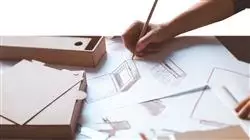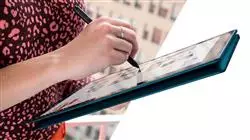University certificate
The world's largest faculty of design”
Introduction to the Program
With this program, which is developed in a 100% online format, you will learn all the keys to advance your career through Sustainable Product Design"

Growing social awareness of environmental problems has led to major changes in production and consumption patterns. Today, companies are not only looking for profitable business models, but also for sustainable ones. For this reason, one of the most sought-after professional profiles today is that of a product designer specialized in sustainability.
This is a figure that is increasingly in demand but, for the moment, is not very abundant. For that reason, becoming a great expert in this field can bring the designer closer to great job opportunities. Thus, this program has been specifically designed to provide the professional with the most outstanding techniques and tools for sustainable creation.
Throughout this Professional master’s degree, you will be able to delve into issues such as entrepreneurship in the creative industries, renewable energies and international sustainable development or the main methodologies of eco-design, among many other innovative contents. All this, following an online teaching system that will allow the designer to combine his work with his studies, since it will allow him to choose the time and place to study, without being subjected to rigid schedules or uncomfortable trips to an academic center.
You will have at your disposal the latest contents on the main Eco-Design methodologies, presented with the most advanced multimedia resources"
This Professional master’s degree in Sustainable Product Design contains the most complete and up-to-date program on the market. The most important features include:
- The development of case studies presented by experts in Sustainable Design
- The graphic, schematic, and eminently practical contents with which they are created, provide scientific and practical information on the disciplines that are essential for professional practice
- Practical exercises where the self-assessment process can be carried out to improve learning
- Its special emphasis on innovative methodologies
- Theoretical lessons, questions to the expert, debate forums on controversial topics, and individual reflection assignments
- Content that is accessible from any fixed or portable device with an Internet connection
Large design firms are looking for specialists to adapt to the new context of sustainability and this program will boost you professionally by making you an expert in this field"
The program’s teaching staff includes professionals from sector who contribute their work experience to this training program, as well as renowned specialists from leading societies and prestigious universities.
The multimedia content, developed with the latest educational technology, will provide the professional with situated and contextual learning, i.e., a simulated environment that will provide immersive training programmed to train in real situations.
This program is designed around Problem-Based Learning, whereby the professional must try to solve the different professional practice situations that arise during the academic year. For this purpose, the student will be assisted by an innovative interactive video system created by renowned and experienced experts.
This program will allow you to delve into issues such as the fundamentals of creativity or corporate social responsibility"

The best educational technology will be at your fingertips to become the best Designer Specializing in Sustainability in your environment"
Why study at TECH?
TECH is the world’s largest online university. With an impressive catalog of more than 14,000 university programs available in 11 languages, it is positioned as a leader in employability, with a 99% job placement rate. In addition, it relies on an enormous faculty of more than 6,000 professors of the highest international renown.

Study at the world's largest online university and guarantee your professional success. The future starts at TECH”
The world’s best online university according to FORBES
The prestigious Forbes magazine, specialized in business and finance, has highlighted TECH as “the world's best online university” This is what they have recently stated in an article in their digital edition in which they echo the success story of this institution, “thanks to the academic offer it provides, the selection of its teaching staff, and an innovative learning method aimed at educating the professionals of the future”
A revolutionary study method, a cutting-edge faculty and a practical focus: the key to TECH's success.
The most complete study plans on the university scene
TECH offers the most complete study plans on the university scene, with syllabuses that cover fundamental concepts and, at the same time, the main scientific advances in their specific scientific areas. In addition, these programs are continuously being updated to guarantee students the academic vanguard and the most in-demand professional skills. In this way, the university's qualifications provide its graduates with a significant advantage to propel their careers to success.
TECH offers the most comprehensive and intensive study plans on the current university scene.
A world-class teaching staff
TECH's teaching staff is made up of more than 6,000 professors with the highest international recognition. Professors, researchers and top executives of multinational companies, including Isaiah Covington, performance coach of the Boston Celtics; Magda Romanska, principal investigator at Harvard MetaLAB; Ignacio Wistumba, chairman of the department of translational molecular pathology at MD Anderson Cancer Center; and D.W. Pine, creative director of TIME magazine, among others.
Internationally renowned experts, specialized in different branches of Health, Technology, Communication and Business, form part of the TECH faculty.
A unique learning method
TECH is the first university to use Relearning in all its programs. It is the best online learning methodology, accredited with international teaching quality certifications, provided by prestigious educational agencies. In addition, this disruptive educational model is complemented with the “Case Method”, thereby setting up a unique online teaching strategy. Innovative teaching resources are also implemented, including detailed videos, infographics and interactive summaries.
TECH combines Relearning and the Case Method in all its university programs to guarantee excellent theoretical and practical learning, studying whenever and wherever you want.
The world's largest online university
TECH is the world’s largest online university. We are the largest educational institution, with the best and widest online educational catalog, one hundred percent online and covering the vast majority of areas of knowledge. We offer a large selection of our own degrees and accredited online undergraduate and postgraduate degrees. In total, more than 14,000 university degrees, in eleven different languages, make us the largest educational largest in the world.
TECH has the world's most extensive catalog of academic and official programs, available in more than 11 languages.
Google Premier Partner
The American technology giant has awarded TECH the Google Google Premier Partner badge. This award, which is only available to 3% of the world's companies, highlights the efficient, flexible and tailored experience that this university provides to students. The recognition as a Google Premier Partner not only accredits the maximum rigor, performance and investment in TECH's digital infrastructures, but also places this university as one of the world's leading technology companies.
Google has positioned TECH in the top 3% of the world's most important technology companies by awarding it its Google Premier Partner badge.
The official online university of the NBA
TECH is the official online university of the NBA. Thanks to our agreement with the biggest league in basketball, we offer our students exclusive university programs, as well as a wide variety of educational resources focused on the business of the league and other areas of the sports industry. Each program is made up of a uniquely designed syllabus and features exceptional guest hosts: professionals with a distinguished sports background who will offer their expertise on the most relevant topics.
TECH has been selected by the NBA, the world's top basketball league, as its official online university.
The top-rated university by its students
Students have positioned TECH as the world's top-rated university on the main review websites, with a highest rating of 4.9 out of 5, obtained from more than 1,000 reviews. These results consolidate TECH as the benchmark university institution at an international level, reflecting the excellence and positive impact of its educational model.” reflecting the excellence and positive impact of its educational model.”
TECH is the world’s top-rated university by its students.
Leaders in employability
TECH has managed to become the leading university in employability. 99% of its students obtain jobs in the academic field they have studied, within one year of completing any of the university's programs. A similar number achieve immediate career enhancement. All this thanks to a study methodology that bases its effectiveness on the acquisition of practical skills, which are absolutely necessary for professional development.
99% of TECH graduates find a job within a year of completing their studies.
Professional Master's Degree in Sustainable Product Design.
TECH Global University presents the Professional Master's Degree in Sustainable Product Design, a high-level educational program aimed at designers, engineers and professionals interested in the design of sustainable and environmentally friendly products. It delves into the philosophy of responsible and sustainable design, offering the necessary tools to develop products that are environmentally friendly, socially responsible and economically viable. In addition, the principles of eco-design are analyzed and practical cases are studied to understand how these principles are applied in the real world. The Professional Master's Degree in Sustainable Product Design at TECH Global University is taught 100% online, which allows for greater flexibility and convenience when studying. In addition, thanks to its methodology of virtual classes, you can interact with professionals and industry experts from anywhere in the world.
Become an expert and deepen your knowledge of responsible and sustainable design.
The program is composed of a highly qualified and experienced teaching team in the sector, which will accompany you throughout the learning process and help you develop your skills in sustainable product design. Some of the topics covered in the Professional Master's Degree in Sustainable Product Design are product life cycle assessment, eco-innovation, circular economy, waste management and carbon footprint analysis. All this with the aim of training professionals capable of creating innovative and sustainable products that contribute to the improvement of the environment and society. If you want to specialize in sustainable product design and develop skills that allow you to create responsible and environmentally friendly products, the Professional Master's Degree in Sustainable Product Design at TECH Global University is what you are looking for. Don't miss the opportunity to learn from the best experts in the sector!







